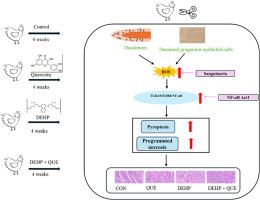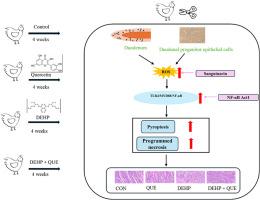槲皮素通过调控TLR4/MyD88/NF-κB通路减轻dehp诱导的鸡十二指肠焦亡和程序性坏死
IF 7.3
2区 环境科学与生态学
Q1 ENVIRONMENTAL SCIENCES
引用次数: 0
摘要
邻苯二甲酸二(2-乙基己基)酯(DEHP)不仅是一种广泛使用的增塑剂,而且在环境中无处不在,对家禽的生命和健康造成重大威胁。槲皮素是一种具有抗氧化、抗炎、抗癌和免疫调节作用的天然类黄酮。然而,目前尚不清楚DEHP是否会导致肉鸡十二指肠焦亡和程序性坏死,或者QUE是否在这一机制中起到缓解作用。因此,本研究建立基于DEHP和QUE暴露的组织和十二指肠祖细胞模型,并在体外实验中添加核因子κ b激活剂1 (NF-κB Act1)和活性氧激活剂(Sanguinarine)。采用免疫荧光、western blot、qRT-PCR等方法探讨十二指肠损伤的机制。结果表明,DEHP暴露导致鸡十二指肠隐窝深度减小,纤毛长度缩短,氧化应激标志物上调,抗氧化标志物下调,ROS表达显著增强。DEHP还促进了TLR4/MyD88/NF-κB通路的表达,以及与焦亡和程序性坏死相关基因的表达。而DEHP + QUE联合治疗组,QUE可调节十二指肠抗氧化能力,抑制TLR4/MyD88/NF-κB通路,在一定程度上减轻DEHP诱导的焦亡和程序性坏死。在体外实验中,在共处理组中加入NF-κB Act1和Sanguinarin, NF-κB信号被激活,并重新上调QUE减轻的细胞焦亡和程序性坏死相关基因的水平,进一步证明该途径对鸡十二指肠焦亡和程序性坏死具有调节作用。由此可见,槲皮素通过调控TLR4/MyD88/NF-κB减轻dehp诱导的鸡十二指肠焦亡和程序性坏死。本研究为增塑剂DEHP对家禽的危害评价提供了理论依据。本文章由计算机程序翻译,如有差异,请以英文原文为准。


Quercetin attenuates DEHP-induced pyroptosis and programmed necrosis in chicken duodenum through regulation of the TLR4/MyD88/NF-κB pathway
Di(2-ethylhexyl) phthalate (DEHP) is not only popularly used as a plasticizer, but also ubiquitous in environment, causes an important risk to the lives and well-being of poultry. Quercetin (QUE) is a natural flavonoid with antioxidant, anti-inflammatory, anticancer and immunoregulation. Nevertheless, it's still unclear possibly DEHP causes duodenal pyroptosis and programmed necrosis in broiler chickens or perhaps QUE has a mitigating impact in this mechanism. Therefore, the present investigation was conducted to establish a model of tissue and duodenal progenitor cells models based on DEHP and QUE exposure, and in vitro experiments were added the nuclear factor-kappa-B activator1 (NF-κB Act1) and reactive oxygen species activator (Sanguinarine). The mechanism of duodenal injury was explored by immunofluorescence, Western blot and qRT-PCR. It was shown that exposure to DEHP resulted in decreased depth of the duodenal crypt, shortened cilia length, upregulation of oxidative stress markers, downregulation of antioxidant markers, and a significant increase in the promotion of ROS expression in chicken duodenum. DEHP also promoted the expression of the TLR4/MyD88/NF-κB pathway, as well as the expression of genes associated with pyroptosis and programmed necrosis. While in the DEHP + QUE co-treatment group, QUE regulated the antioxidant capacity of the duodenum and inhibited the TLR4/MyD88/NF-κB pathway, which reduced DEHP-induced pyroptosis and programmed necrosis to some extent. In in vitro experiments where NF-κB Act1 and Sanguinarin were added to the co-treated treatment group, NF-κB signalling was activated and re-up-regulated the levels of genes related to cellular pyroptosis and programmed necrosis alleviated by QUE, which further demonstrated that this pathway could regulate chicken duodenal pyroptosis and programmed necrosis. Thus, quercetin alleviated DEHP-induced chicken duodenal pyroptosis and programmed necrosis via the regulation of the TLR4/MyD88/NF-κB. This investigation supplies a theoretical footing for the hazard valuation of the plasticizer DEHP for poultry.
求助全文
通过发布文献求助,成功后即可免费获取论文全文。
去求助
来源期刊

Environmental Pollution
环境科学-环境科学
CiteScore
16.00
自引率
6.70%
发文量
2082
审稿时长
2.9 months
期刊介绍:
Environmental Pollution is an international peer-reviewed journal that publishes high-quality research papers and review articles covering all aspects of environmental pollution and its impacts on ecosystems and human health.
Subject areas include, but are not limited to:
• Sources and occurrences of pollutants that are clearly defined and measured in environmental compartments, food and food-related items, and human bodies;
• Interlinks between contaminant exposure and biological, ecological, and human health effects, including those of climate change;
• Contaminants of emerging concerns (including but not limited to antibiotic resistant microorganisms or genes, microplastics/nanoplastics, electronic wastes, light, and noise) and/or their biological, ecological, or human health effects;
• Laboratory and field studies on the remediation/mitigation of environmental pollution via new techniques and with clear links to biological, ecological, or human health effects;
• Modeling of pollution processes, patterns, or trends that is of clear environmental and/or human health interest;
• New techniques that measure and examine environmental occurrences, transport, behavior, and effects of pollutants within the environment or the laboratory, provided that they can be clearly used to address problems within regional or global environmental compartments.
 求助内容:
求助内容: 应助结果提醒方式:
应助结果提醒方式:


